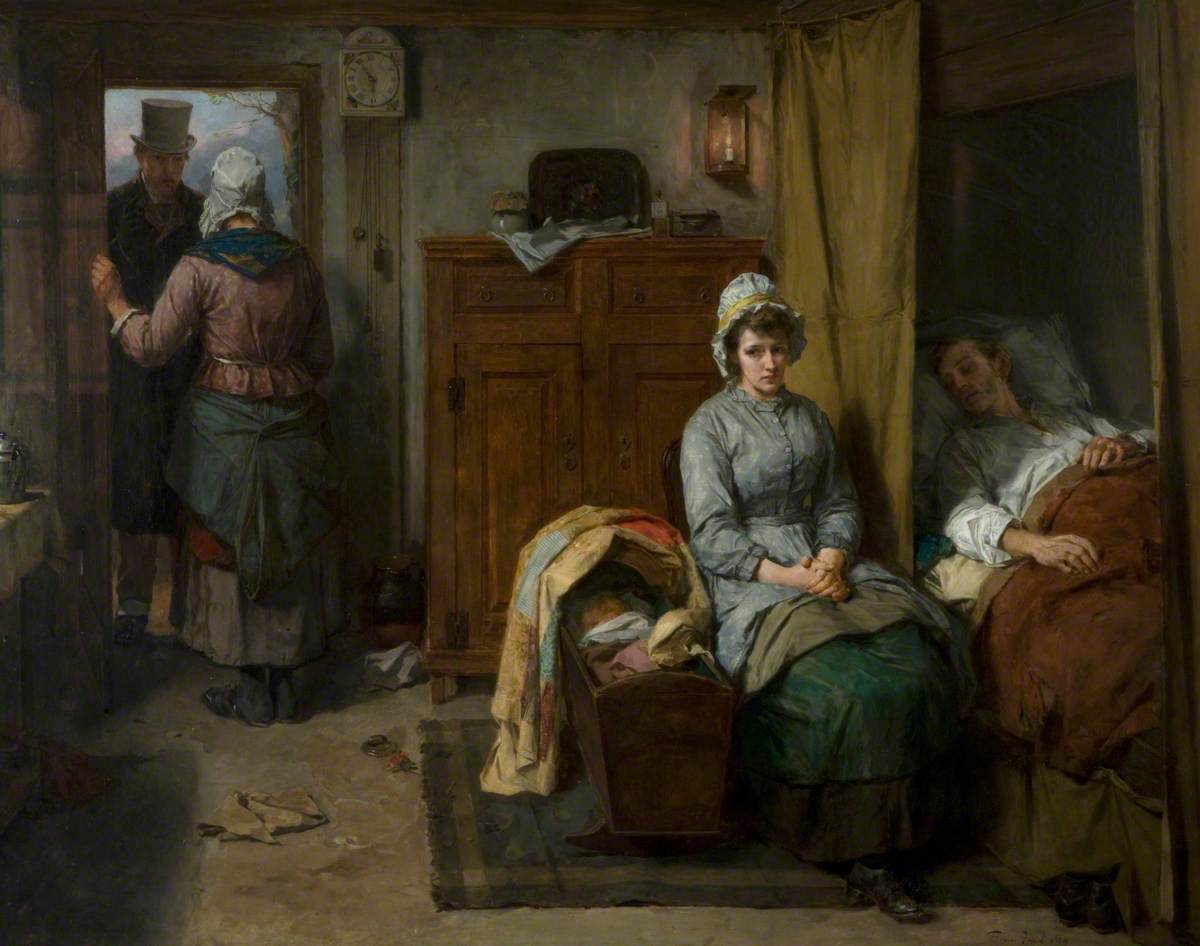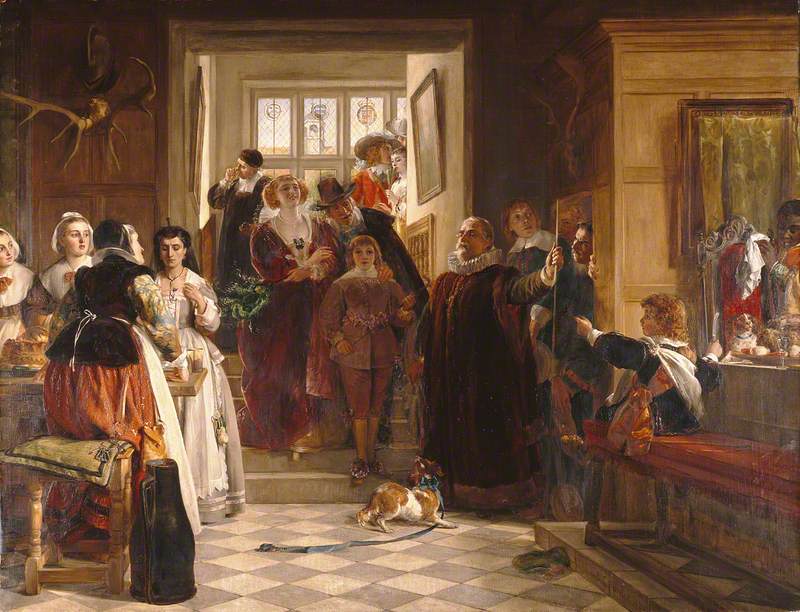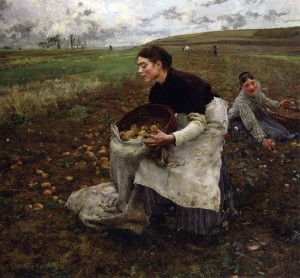This is the third and final post exploring food and drink in Scotland during the late 18th and early 19th centuries. Here we look at the provision of food as payment, examples of when food was scarce, and the link between food and health.
Provision of food
There are many examples found in the Statistical Accounts of Scotland of food being provided as payment for services rendered. “Of old times, and at this very day, there is a proverb used in the Highlands, which, when translated, expresses literally, that it is, for decent food and accommodation, and not for wages, they (domestic servants) serve.” (OSA, Vol. XVI, 1795, p. 195) In Fossoway, County of Perth, “the wages of an able day-labourer throughout the year, is 1 s per day; the wages of a woman for the harvest, 8 d; for men between 10 d and 1 s per day; with breakfast and dinner for both.” (OSA, Vol. XVIII, 1796, p. 462) In the parish of King Edward, County of Aberdeen, it was reported that all rent was paid in grain (OSA, Vol. XI, 1794, p. 403), whereas tenants in the parish of Slamanan, County of Stirling, generally paid most of their rent with butter and cheese. (OSA, Vol. XIV, 1795, p. 83)
Interestingly, one landlord in the parish of North Knapdale, County of Argyle, had his rent paid to him chiefly “in feasts given at the habitations of his tenants. What he was to spend, and the time of his residence at each village, was known, and provided for accordingly. The men who provided these entertainments partook of them; they all lived friends together; and the departures of the chief and his retinue never failed to occasion regret.” This ‘friendship’, however, had changed in more modern times. “Till very lately, in this neighbourhood, Campbell of Auchinbreck had a right to carry off the best cow he could find upon several properties, at each Martinmas, by way of mart… The Crown now has converted these cows at 20 s. a head, and taken away this badge of slavery.” (OSA, Vol. VI, 1793, p. 257)
It was not just about farmers and farm-labourers. In the Statistical Accounts, you can also discover the eating habits of those working in mills at the time. In the parish of New Abbey, County of Kirkcudbright, it was reported that women who worked spinning yarn “make sorry wages of it, not above 3 d. per day;-which can afford very scanty food”. (OSA, Vol. II, 1792, p. 132)

Towne, Charles; Backbarrow Cotton Mill, near Newby Bridge; Lakeland Arts Trust; http://www.artuk.org/artworks/backbarrow-cotton-mill-near-newby-bridge-145131
In Lanark, County of Lanark, the diet of children working in the mills “consists of oatmeal porridge, with milk in summer or sowens, i.e. oat-meal flummery, with milk in winter twice a day, as much as they can take, barley broth for dinner made with good fresh beef every day and as much beef is boiled as will allow 7 ounces English a piece each day to one half of the children, the other half get cheese and bread after their broth, so that they dine alternately upon cheese and butchermeat with barley bread or potatoes; and now and then in the proper season they have a dinner of herrings and potatoes. They as well as the others, begin work at six in the morning, are allowed half an hour to breakfast, an hour to dinner, and quit work at 7 at night; after which they attend the school at the expense of the proprietor till 9.” (OSA, Vol. XV, 1795, p. 37) In Lochwinnoch, County of Renfrew, ” the persons employed in the cotton-mills work twelve hours five days in the week, and nine hours on Saturday. They have one hour and forty minutes for both breakfast and dinner.” (NSA, Vol. VII, 1845, p. 104)
There is even an example given of what prisoners ate! In Linlithgow, County of Linlithgow, the prisoners’ “diet is excellent, consisting of six ounce of oatmeal made into porridge, for breakfast, with three-fourths of a pint of buttermilk. Dinner, ox-head broth, four ounce barley, four ounce bread, and a proportion of vegetables, each alternate day, pease-brose, fish, and potatoes. Supper the same as breakfast.” (NSA, Vol. II, 1845, P. 187)
Food scarcity
Some parish reports mention the years 1782 and 1783 in particular, when many harvests in Scotland failed. It is really interesting to read about what caused the failure of crops, according to the parish report of Kilwinning, County of Ayrshire.
“Different causes, no doubt, contributed to this failure, in different parts of the country: But in this parish, and in others immediately on the sea coast, the chief cause of its failure was owing to a very severe west wind, about the middle, or towards the latter end of the month of August, which continued with the utmost violence for a considerable time. The corns had their roots loosened, and were otherwise much damaged by this storm. From being in general very green, when it happened, in a few days afterwards they grew white, but never filled. Snow also, in such parts of the parish as were at the greatest distance from the sea, fell earlier, and in greater quantities, than ever had been known at that season of the year.” (OSA, Vol. XI, 1794, p. 153)
In Peterhead, County of Aberdeen, “the crop of 1782 was as defective in this parish as in other parts of Scotland; and without very great efforts, both of a public and private nature, many would have perished for want of food.” Everyone rallied together to avert death and suffering. This included “a considerable quantity of meal sent by Government, partly gratis, and partly at a low price” and “collections were made in the different churches, and voluntary assessments raised from the greatest part of the heritors”. (OSA, Vol. XVI, 1795, p. 579)
In Gargunnock, County of Stirling, “a large quantity of white peas being commissioned from England by a man of public spirit, and grinded into meal, assisted the other expedients which were then adopted to prevent a famine in this part of the kingdom.” (OSA, Vol. XVIII, 1796, p. 121) The parish of Kilmadan, County of Argyle, was not so hard hit as others, “but the crop in general, over the whole, suffered from the summer’s cold and the wet harvest. The poor were the better for the supply granted by Government.” (OSA, Vol. IV, 1792, p. 340) A particularly poignant account of food scarcity during these years and the affect it had on people can be found in the parish report of Keithhall, County of Aberdeen. “One family wanted food from Friday night till Sunday at dinner”.(OSA, Vol. II, 1792, p. 544)
A long period of food scarcity was also experienced in the parish of Kilsyth, County of Stirling, during the last seven years of the 17th century (also know as the seven dear years). The price of food became exorbitant and even the more opulent residents could not buy any corn. “Greens boiled with salt, became a common food. Fodder was as scarce as grain. Many of the cattle perished at the stall, and many of them who were driven out to seek a scanty pittance expired in the field.” (OSA, Vol. XVIII, 1796, p. 302)
Food and health
There are several mentions of the link between food and health in the Statistical Accounts, with some opinions apperaing contradictory! In the parish of Carsphairn, County of Kirkcudbright, “scurvies are little known, though most of the inhabitants live all the year round on salted provisions, which they use in great abundance. The pernicious consequences of this mode of living are obviated by the plentiful use of potatoes, and other vegetables.” (OSA, Vol. VII, 1793, p. 514)
It was noted in the report for Kilbrandon and Kilchattan, County of Argyle, that “dropsies are likewise observed of late to be more frequent, particularly since potatoes have become the principal food of the lower classes of the people. And certainly, though this useful and wholesome root contains no hurtful quality, yet change of diet must gradually affect and change the constitution. While many, therefore, whole food was more solid in their early period of life, and to whom this root was scarcely known, but now live by this three-fourths of the year, no wonder though disorders should prevail which were formerly less common.” (OSA, Vol. XIV, 1795, p. 160)
In the parish of Kelso, County of Roxburgh, it was thought that the food eaten by the labouring classes and the large quantity “may be one cause of laying the foundation of glandular and visceral diseases. Although the mechanics in town generally eat meat for dinner, the labourers in town and country seldom do so; but one and all of them live much upon hasty pudding, and boiled potatoes with milk; without deviation, they all breakfast or sup upon the one or the other. Most of the adults eat of this food, at a meal, from 6 to 8 English pounds weight, including milk”, resulting in various unpleasant complaints and even death. (OSA, Vol. X, 1794, p. 594) In this parish, the sheer amount of food people ate, as well as the “sudden change from vegetable to animal food and the too frequent use of spirituous liquors” was believed to inflict many health problems on its residents.

Faed, Thomas; The Doctor’s Visit; 1889. Queen’s University, Belfast; http://www.artuk.org/artworks/the-doctors-visit-168946
In Banff, “an infectious fever prevailed here, with unusual violence, about the year 1782. Unwholesome food, particularly an immoderate use of potatoes, (that year of a bad kind), were among the secondary causes to which this fever was ascribed.” (As you know, the year 1782 was a bad year for crops!) Mr Skene, “the late minister of this parish, wrote a wrote a small treatise on this fever, in form of a “Serious Address to the People,” etc. This short address, which Provost Robinson had paid to print and publish, “contained several plain sensible instructions respecting the prevention and treatment of the disease, and points out the means by which health may be preserved from every disorder of an infectious nature.” For examples of his recommendations see OSA, Vol. XX, 1798, p. 347.
Scrofula was a disease that had prevailed in times of food scarcity (when food was lacking in both quantity and quality) in the parish of Duthil, County of Elgin. “In the summers of 1808, 1816, and 1817, many families subsisted for several successive weeks on the tops of nettles, mugwort, turnip thinnings, and milk, without any corn food; and such as subsisted on this miserable substitute for food, are labouring under the […] disease.” (NSA, Vol. XIII, 1845, p. 125) There was, however, better news for residents of the parish of Borgue, County of Kirkcudbright. “From greater attention to cleanliness, and a more plentiful use of vegetables and fresh animal food, scorbutic and cutaneous diseases are less prevalent than formerly.” (OSA, Vol. XI, 1794, p. 34)
Surprisingly, tea was seen as bad for the health in several parish reports! In the parish of Delting, County of Shetland, some thought that the increase of diseases “may be ascribed to the change in the mode of living, especially to the general use of tea, of which the consumption is amazing, even in the poorest families, who will stint themselves in many essential necessaries of life, in order to procure this article of luxury.” (OSA, Vol. I, 1791, p. 386) This extract on the use of tea found in the report for Gargunnock, County of Stirling, is very amusing. “Tea is universally used. Even the poorest families have it occasionally, and the last cup is qualified with a little whisky, which is supposed to correct all the bad effects of the tea.” (OSA, Vol. XVIII, 1796, p. 121) Conversely, in the parish report for Kirkcudbright, County of Kirkcudbright, tea and coffee are called “wholesome and enlivening beverages”. (NSA, Vol. IV, 1845, p. 37)
Conclusions
It has been fascinating to discover what the Scots ate and drank during the times of the Statistical Accounts. People had to grow and rear what they could to eat. This makes us think that those in the countryside would have had a better diet than those in the cities. But, this was not necessarily always the case. There were certainly differences between parishes due to their topography and climate. In some cases, inhabitants did not make the most of what the land and water had to offer, either because of a lack of knowledge and/or not enough hard work! There were also periods of food scarcity due to poor harvests, which affected everyone, both rich and poor. It must also be pointed out that, in many instances, the farmers sold their produce in the town and city markets.
Looking through the reports, it is clear that many changes took place between the Old and New Statistical Accounts, with improved agricultural practices and a growth in industry and technology, all resulting in increased production and trade. These benefited both those in the country and those in built-up areas. It was particularly interesting to find out what and when mill workers ate during the day, as well as what the link between food and health was believed to be in the eighteenth and nineteenth centuries. There is a wealth of information on food and drink in the Statistical Accounts. Why not explore it and see what you can find?



